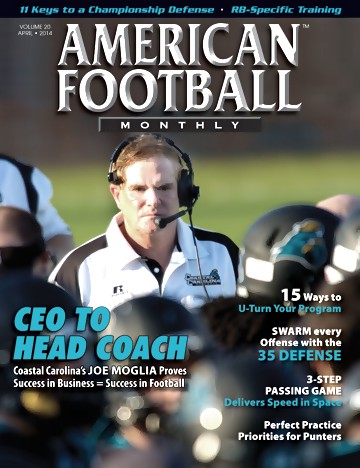The Coach’s Role on the Athletic Health Care Team
by: Melinda Flegel©
More from this issue
As a coach, you are likely to be involved in each portion of the athletic health care relay – prevention, recognition and first aid care, assessment and treatment, and rehabilitation.
Your roles are defined by
• Certain rules of the legal system and rules of your school administration,
• Expectations of parents, and
• Interactions with other athletic health care team members.
Legal Definitions of Your Role
Basically, the legal system supports the theory that a coach’s primary role is to minimize the risk of injury to the athletes under the coach’s supervision. This encompasses a variety of duties.
1. Properly plan the activity.
• Teach the skills of the sport in the correct progression.
• Consider each athlete’s developmental level and current physical condition. Evaluate your athletes’ physical capacity and skill level with preseason fitness tests, and develop practice plans accordingly.
• Keep written records of fitness test results and practice plans. Don’t deviate from your plans without good cause.
2. Provide proper instruction.
• Make sure that athletes are in proper condition to participate.
• Teach athletes the rules and the correct skills and strategies of the sport. For example, in football teach athletes that tackling with the head (spearing) is illegal and also a potentially dangerous technique.
• Teach athletes the sport skills and conditioning exercises in a progression so that the athletes are adequately prepared to handle more difficult skills or exercises.
• Keep up-to-date on better and safer ways of performing the techniques used in the sport.
• Provide competent and responsible assistants. If you have coaching assistants, make sure that they are knowledgeable in the skills and strategies of the sport and act in a mature and responsible manner.
3. Warn of inherent risks.
• Provide parents and athletes with both oral and written statements of the inherent health risks of their particular sport.
• Also warn athletes about potentially harmful conditions, such as playing conditions, dangerous or faulty equipment, and the like.
4. Provide a safe physical environment.
• Monitor current environmental conditions (i.e., windchill, temperature, humidity, and severe weather warnings).
• Periodically inspect the playing areas, the locker room, the weight room, and the dugout for hazards.
• Remove all hazards.
• Prevent improper or unsupervised use of facilities.
5. Provide adequate and proper equipment.
• Make sure athletes are using equipment that provides the maximum amount of protection against injury.
• Inspect equipment regularly.
• Teach athletes how to fit, use, and inspect their equipment.
6. Match your athletes appropriately.
• Match the athletes according to size, physical maturity, skill level, and experience.
• Do not pit physically immature or novice athletes against those who are in top condition and are highly skilled.
7. Evaluate athletes for injury or incapacity.
• Require all athletes to submit to preseason physicals and screenings to detect potential health problems.
• Withhold an athlete from practice and competition if the athlete is unable to compete without pain or loss of function (e.g., inability to walk, run, jump, throw, and so on without restriction).
8. Supervise the activity closely.
• Do not allow athletes to practice difficult or potentially dangerous skills without proper supervision.
• Forbid horseplay, such as “wrestling around.”
• Do not allow athletes to use sports facilities without supervision.
9. Provide appropriate emergency assistance.
• Learn sport first aid and cardiopulmonary resuscitation (CPR). (Take a course through the American Red Cross, American Heart Association, or the National Safety Council.)
• Take action when needed. The law assumes that you, as a coach, are responsible for providing first aid care for any injury or illness suffered by an athlete under your supervision. So, if no medical personnel are present when an injury occurs, you are responsible for providing emergency care.
• Use only the skills that you are qualified to administer and provide the specific standard of care that you are trained to provide through sport first aid, CPR, and other sports medicine courses.
• If athlete is a minor, obtain a signed written consent form from their parents before the season. For injured adult athletes, specifically ask if they want help. If they are unresponsive, consent is usually implied. If they refuse help, you are not required to provide it. In fact, if you still attempt to give care, they can sue you for assault.
Some states expect coaches to meet additional standards of care. Check with your athletic director to find out if your state has specific guidelines for the quality of care to be provided by coaches.
You should become familiar with each of these 9 legal duties. The first 8 duties deal mainly with preventive measures, which are explained more thoroughly in chapter 2. This book is primarily designed to help you handle duty number 9.
Parental Expectations
Parents will look to you for direction when their child is injured. They may ask questions such as these:
- What do you think is wrong with my child’s knee?
- Will it get worse if my child continues playing?
- Should my child see a doctor?
- Does my child need to wear protective knee braces for football?
- Will taping help prevent my child from reinjuring the ankle?
- When can my child start competing again?
While you can’t have all the answers, it helps to know those who can. That’s where the other athletic health care team members can help.
Editor’s note: The preceding is an excerpt from Sport First Aid, Fifth Edition (Human Kinetics, 2013), written by Melinda Flegel. Sport First Aid is the textbook for the Sport First Aid course, available through the Human Kinetics Coach Education Program and used by the majority of state high school associations, athletic directors associations, and school districts for certifying high school coaches. The Sport First Aid text and course are available at www.HumanKineticsCoachEducationCenter.com. (All content provided by Human Kinetics)





